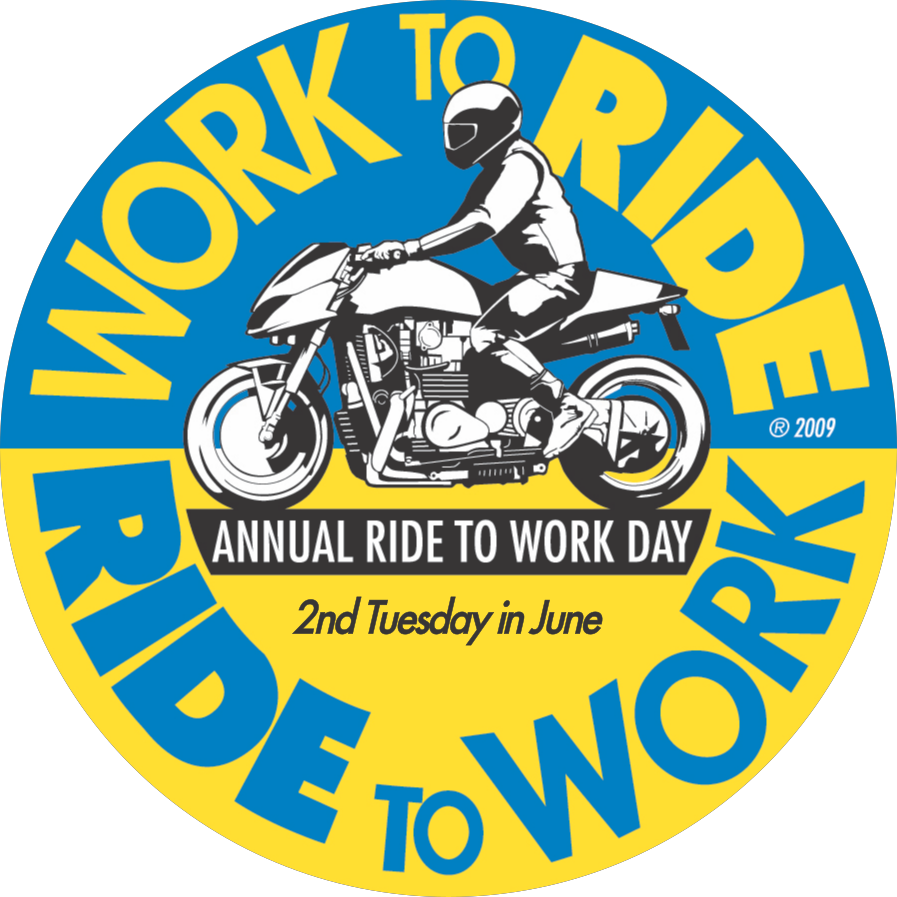RoadRunner Magazine, September 2006:
Riding To Work
By James T. Parks
Motorcycling along my secret back road route to work on a spring morning, I’m completely focused on the ride. With no thought of the challenges waiting at my job, I’m enjoying the fresh scents of budding flowers and some colorful scenery on a two-lane byway curving through an attractive suburban area.
Approaching my office building, the traffic is heavier, but I soon dive underground into the parking garage The attendant and I exchange waves as I’m allowed to bypass the line of cars backed-up at the entrance gate. Pulling into my parking space five levels down, I dismount, remove my protective gear, grab my briefcase and almost skip to the elevators. Entering my office and booting up the computer, I feel energized and know that regardless of how difficult this day may become, I can look forward to putting it all behind me on my ride back home.
Why Motorcycle Commuting Makes Sense
You already know that riding a motorcycle to work is a lot more fun than commuting in a four-wheeled vehicle, but there are also a lot of other compelling reasons for doing it. The Ride to Work organization (www.ridetowork.org), founded by Aero- stitch CEO Andy Goldfine, says that motorcyclists also should ride to work because it:
- Reduces traffic and parking congestion
- Uses less fuel than an automobile
- Leaves riders alert and energized
- Results in less pollution than commuting in a larger vehicle
- Is less destructive to road surfaces and bridges (because of lighter weight)
- Gets riders to work and back home faster
- Demonstrates motorcycling as a social good
With all of these benefits, it’s surprising that more riders don’t commute to work on their motorcycles. According to U.S. Census figures, about 160,000 motorcycles, out of a total of over 6.5 million registered in the USA, are ridden to work regularly. This means only 2.5 percent of all registered motorcycles are used for commuting. When compared to the total number of daily commuters in all types of vehicles, the ratio of motorcycle commuters falls to around one tenth of one percent.
The low ratio of motorcycle commuters, particularly compared to much higher ratios in other highly populated countries, seems to be driven in the U.S. by: (1) the relatively low price of gas and (2) the lack of public policy and employer incentives encouraging motorcycle commuting. Nevertheless, with a little planning and determination, you can join the ranks of dedicated motorcycle commuters, reduce your commuting costs and help promote a positive image of motorcycling.
Route Selection
Route selection is critical to achieving both the psychological benefits of riding to work on a motorcycle and mitigating the risks of rush-hour traffic. Although others may not have the practical luxury of multiple routes to choose from, I have three options for my commute to work.
Option 1 is a 12-lane interstate highway that turns into a veritable exhaust-belching parking lot during the height of rush-hour congestion. Although an HOV motorcycle lane is available, getting across six lanes of traffic to reach it in the midst of caffeine-crazed, cell-phone talking road warriors driving urban assault vehicles can be, shall we say, exciting. The distance from home to work on this route is 12.6 miles.
Option 2 is a six-lane boulevard with stoplights at its numerous intersections and business parking lot entrances. At 12.9 miles, this route is slightly longer than Option 1, but it offers the fastest commute time of the three options. However, the constant ingress and egress of traffic from side streets and parking lots, lane-switching and stop and go driving requires extraordinary rider vigilance in managing the higher risk level.
Option 3, my favorite, is a two-lane byway that curves through bucolic suburban neighborhoods at a moderate and steady pace, has far fewer stoplights and much less traffic flow entering and leaving the roadway than Option 2. And, there are twisty sections of this route with little traffic where I can really…well, let’s not go into that. Although this route is a slightly longer, at 13.0 miles, it’s easily the most enjoyable and requires only a few minutes more in commute time.
Riders should carefully evaluate the pros and cons of each route option available to them before deciding on the one that best meets their needs for a safe and enjoyable ride to work in a reasonable commute time.
Equipment
Part of your motorcycle commuting strategy is being prepared for the unexpected. Here are the pieces of equipment that I find most useful:
- Full-face helmet with a sunblock strip at the top of the visor, for early morning or late afternoon sun, and a reflector band around the bottom of the helmet for riding after dark
- Sunglasses
- Waterproof motorcycle boots for colder months and conservative western style boots in the summer that can be worn with my khaki trousers or dress slacks
- Courier bag for carrying my briefcase and office shoes (when motorcycle boots are used for commuting)
- Leather gloves
- Riding jacket with armor or a riding suit with armor in colder months
- Rainsuit and waterproof shells for gloves
- Cell phone
- Tire repair kit
- Disc brake lock for motorcycle and a heavy-duty cable lock for helmet and jacket so they can be left attached to the motorcycle in the parking garage
- Reflective tape on the rear of motorcycle and some type of reflective apparel for riding after dark
My place of employment allows business casual dress, making the planning and dressing for my motorcycle commute relatively simple. I keep a few personal grooming aids at the office to deal with helmet hair and similar challenges. Motorcycle commuting to employers requiring full business attire takes a little more planning, but many people do it quite successfully.
Survival Strategies
Riding in traffic, particularly with over-stressed commuters in four-wheeled vehicles weighing several thousand pounds, requires a motorcyclist’s complete focus on the road and traffic, and anticipation of potentially dangerous situations. Here is a compilation of motorcycle commuting safety tips I’ve accumulated from personal experience and various other sources:
- Always look at least 12 seconds ahead of your present position to anticipate and avoid hazards
- Assume that drivers do not see you
- Keep your headlight on bright or use supplemental running lights
- Beware of left-turning vehicles, because they account for about half of all motorcycle and car accidents
- Anticipate a vehicle’s change in direction by watching the driver’s head movements, hand motions on the steering wheel or the changing direction of the front tires
- Constantly look for road surface hazards; follow the left tire track of the vehicle in front of you
- At night, watch for sudden tail light movements of the vehicle in front of you as a warning of surface hazards ahead
- Periodically practice quick stops, without sliding tires, in empty parking lots
- Be respectful of, and courteous to, other commuters; don’t do things to antagonize them
- Stop for yellow lights, don’t speed up, because a low-profile motorcycle and an intersection can be a dangerous combination
- Never share a lane with another moving vehicle
- Stay visible by not following directly behind a large vehicle or riding in a driver’s blind spot; try to see the drivers’ eyes in their rear view or side mirrors
- Watch out for animals, particularly in areas where there may be deer traffic
Safe motorcycle commuting also requires a commitment to continuous riding skill improvement. Taking courses, such as the Motorcycle Safety Foundation’s Advanced Rider Course, and reading books and articles about motorcycling proficiency will help keep your safe riding skills honed to a high level.
Just Do It
Although I admire them greatly, I don’t claim to be a hardcore, year-around, ride-in-the- snow motorcycle commuter. But, I do ride to work as much as possible and am never sorry, even when I ride in the rain. Weekday commuting also helps keep my motorcycling skills sharp.
If you haven’t tried commuting to work on your motorcycle, try it, because I’m sure you’ll like it. A good way to show your support for this social good is to be part of the National Ride to Work Day on July 19, 2006 (www.ridetowork.org). Although I can’t possibly reveal my secret route to work, I hope you find yours soon and as Andy Goldfine says, “Ride to Work and Work to Ride.”

